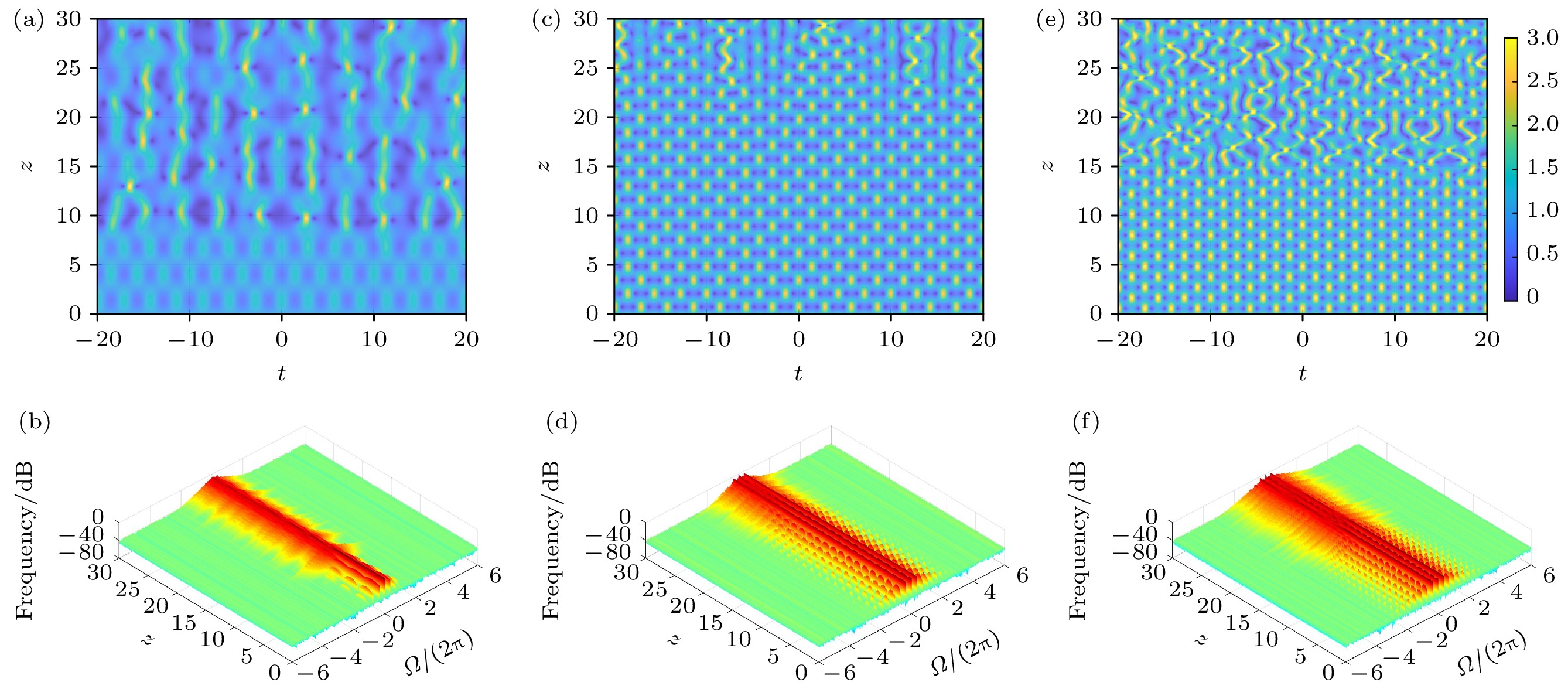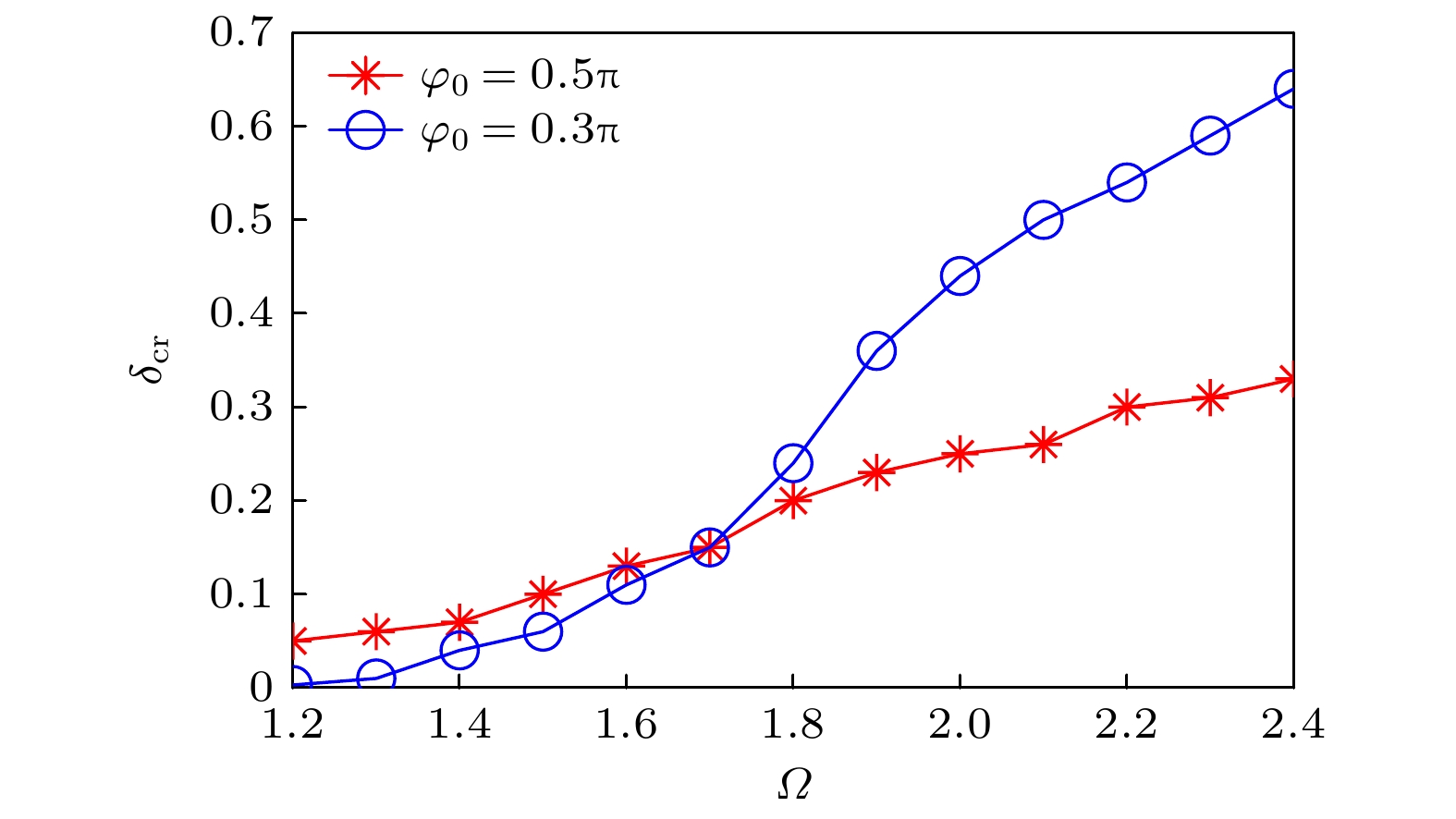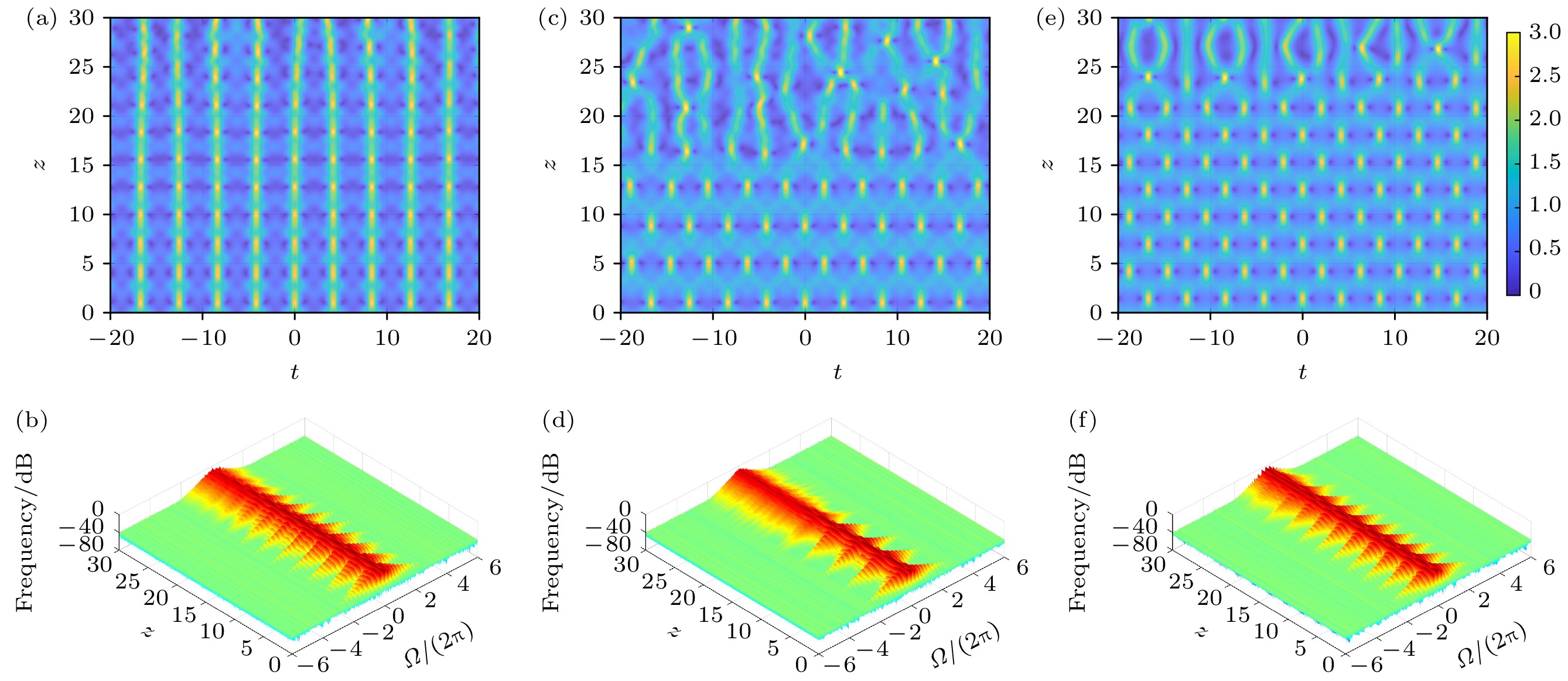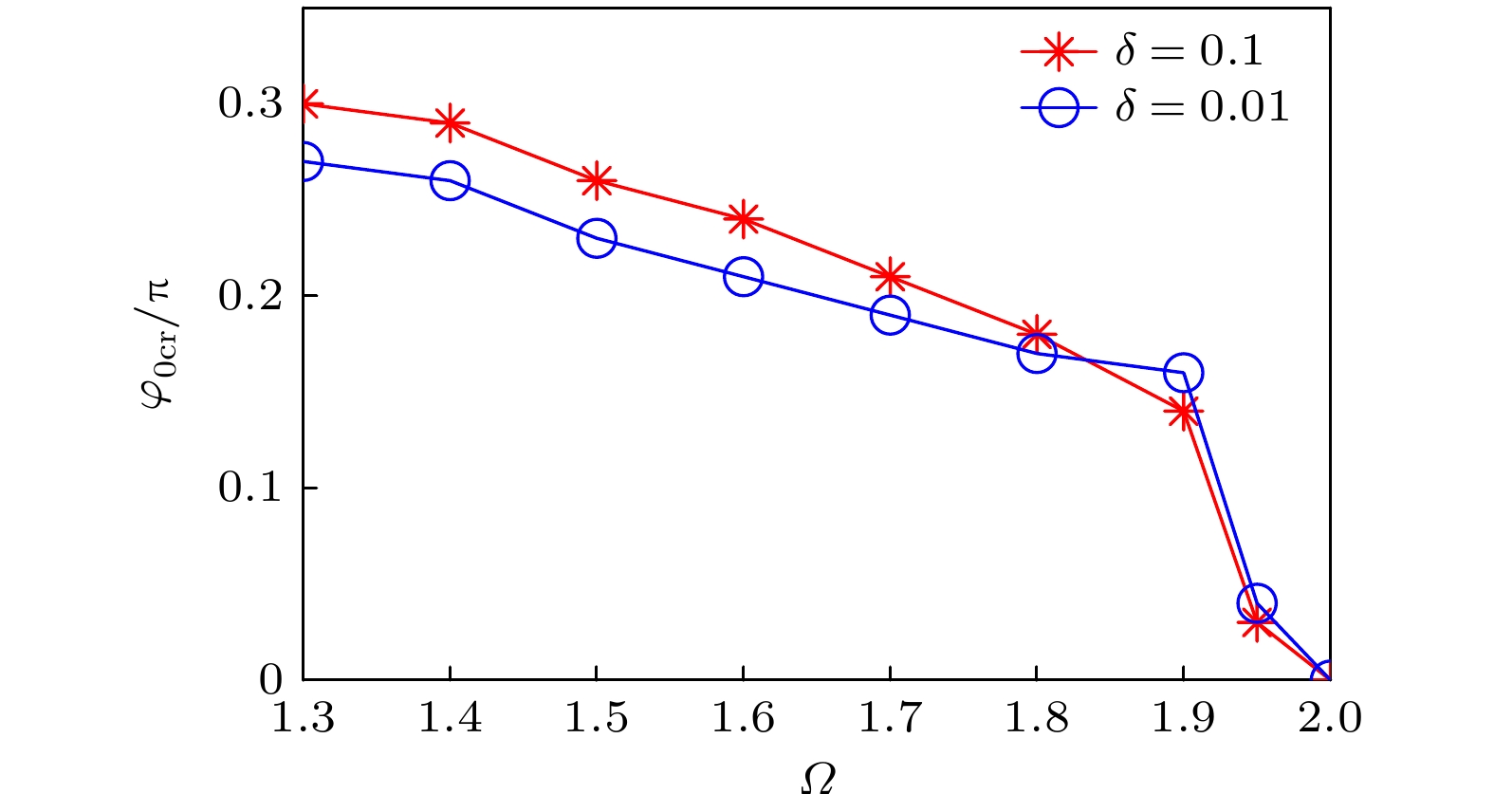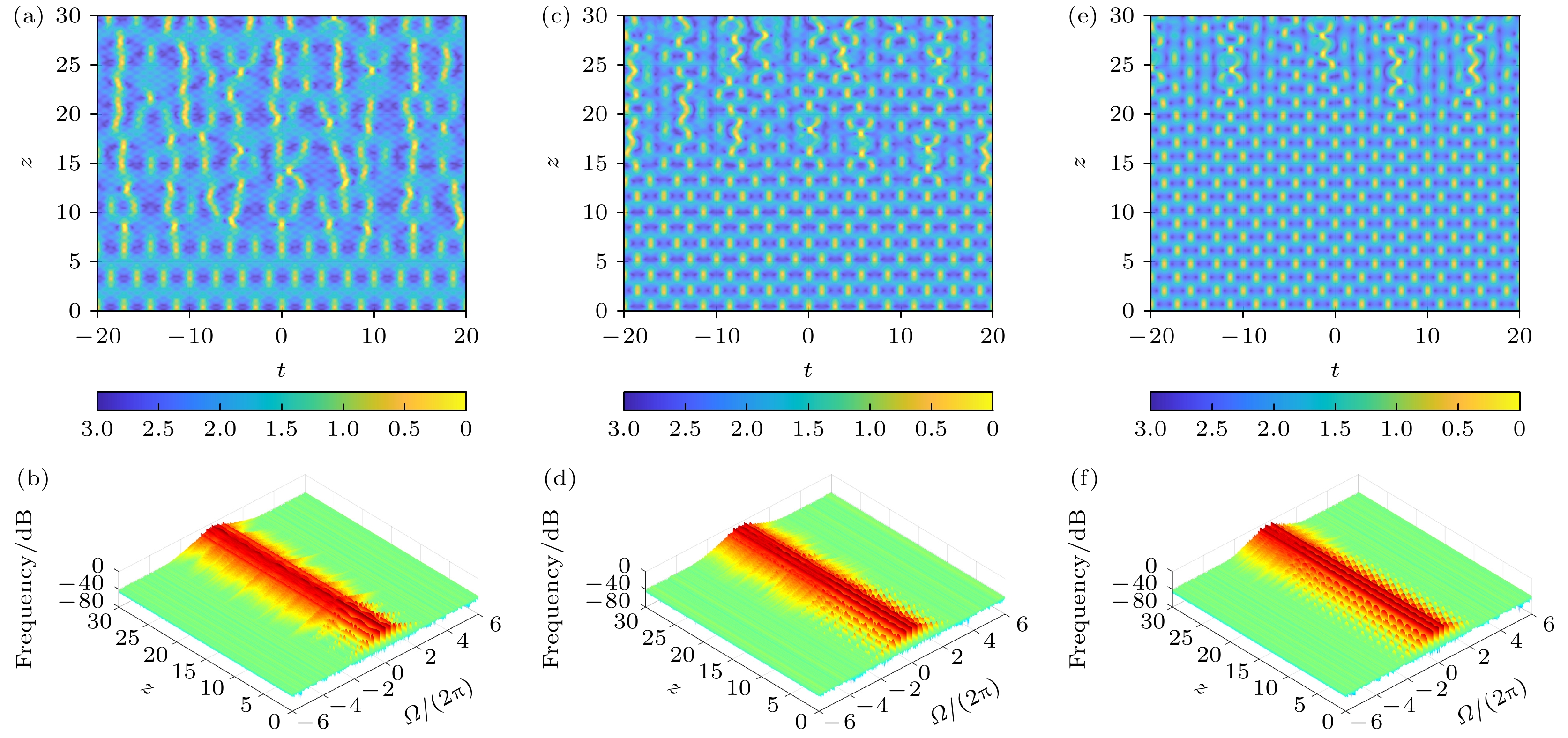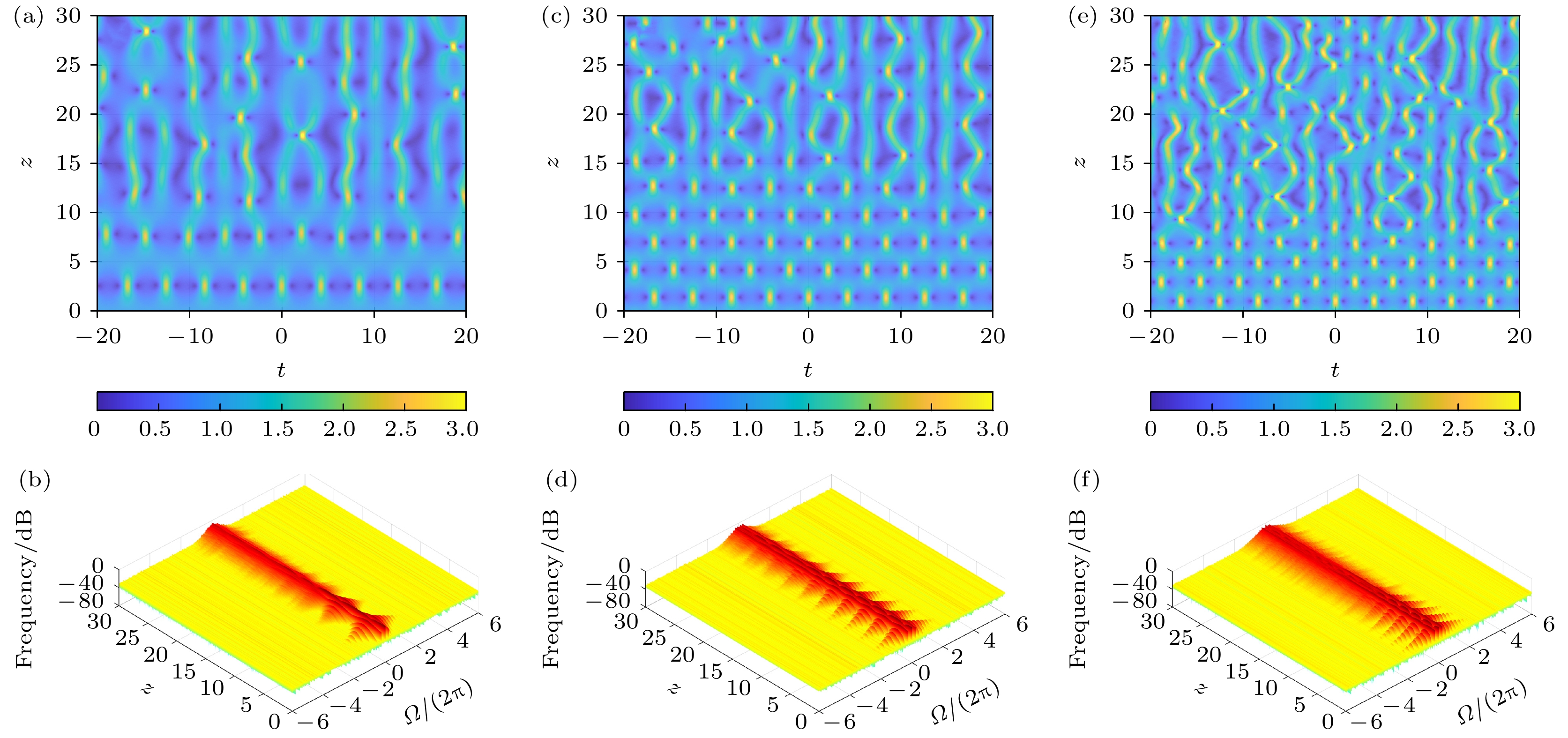-
Stability plays a significant role in successfully observing Fermi-Pasta-Ulam-Tsingou (FPUT) phenomenon in experiment. However, there are few relevant studies in the literature. The primary object of this work is to study the stability of FPUT phenomenon in the nonlinear fibers numerically. In this study, we take the sinusoidally perturbed continuous waves (CWs) with white noise as the imposed initial condition, which can be readily realized in real experiments. We find that both the perturbation amplitude and phase difference between the perturbation and pump can drastically affect the stability of the resulting FPUT phenomenon. Firstly, as the perturbation amplitude increases, the FPUT phenomenon becomes much more stable. When the perturbation amplitude reaches a critical value, the most stable FPUT phenomenon can be observed. With the further increase of the perturbation amplitude, the stability of the resulting FPUT phenomenon weakens. Secondly, the phase difference between the perturbation and pump takes distinct effects on the stability of FPUT phenomenon for perturbation frequency located inside and outside the conventional modulation instability (MI) band. For the perturbation frequency located inside the conventional MI band, as the phase difference between the perturbation and pump increases from zero, the corresponding FPUT phenomenon first is less stable, and then becomes most instable at a critical phase difference; after that, the stability of the FPUT phenomenon is enhanced again. For the perturbation frequency located outside the conventional MI band, the stability of FPUT phenomenon is enhanced monotonically as the phase difference increases from 0 to π/2. In order to observe a much more stable FPUT phenomenon, as shown in the above results, the perturbation amplitude should be moderately large, and the phase difference between the perturbation and the pump should be appropriate to avoid the most instable FPUT phenomenon. [1] Fermi E, Pasta P, Ulam S, Tsingou M 1955 Studies of the Nonlinear Problems Los Alamos, May 1, 1955 pLA-1940
[2] Van Simaeys G, Emplit G, Haelterman M 2001 Phys. Rev. Lett. 87 033902
 Google Scholar
Google Scholar
[3] Akhmediev N N 2001 Nature 413 267
 Google Scholar
Google Scholar
[4] Devine N, Ankiewicz A, Genty G, Dudley J M, Akhmediev N 2011 Phys. Lett. A 375 4158
 Google Scholar
Google Scholar
[5] Wabnitz S, Wetzel B 2014 Phys. Lett. A 378 2750
 Google Scholar
Google Scholar
[6] Chin S A, Ashour O A, Blic M R 2015 Phys. Rev. E 92 063202
 Google Scholar
Google Scholar
[7] Bao C, Jaramillo-Villegas J A, Xuan Y, Leaird D E, Qi M, Weiner A M 2016 Phys. Rev. Lett. 117 163901
 Google Scholar
Google Scholar
[8] Kimmoun O, Hsu H C, Branger H, Li M S, Chen Y Y, Kharif C, Onorato M, Kelleher E J R, Kibler B, Akhmediev N, Chabchoub A 2016 Sci. Rep. 6 28516
 Google Scholar
Google Scholar
[9] Deng G, Li S, Biondini G, Trillo S 2017 Phys. Rev. E 96 052213
 Google Scholar
Google Scholar
[10] Pierangeli D, Flammini M, Zhang L, Marcucci G, Agranat A J, Grinevich P G, Santini P M, Conti C, DelRe E 2018 Phys. Rev. X 8 041017
 Google Scholar
Google Scholar
[11] Naveau C, Szriftgiser P, Kudlinski A, Conforti M, Trillo S, Mussot A 2019 Opt. Lett. 44 763
 Google Scholar
Google Scholar
[12] Vanderhaegen G, Szriftgiser P, Kudlinski A, Conforti M, Trillo S, Droques M, Mussot A 2020 Opt. Express 28 17773
 Google Scholar
Google Scholar
[13] Sheveleva A, Andral U, Kibler B, Colman P, Dudley J M, Finot C 2022 Optica 9 656
 Google Scholar
Google Scholar
[14] Chen S C, Liu C 2022 Physica D 438 133364
 Google Scholar
Google Scholar
[15] Sinthuja N, Rajasekar S, Senthilvelan M 2023 Nonlinear Dyn. 111 16497
 Google Scholar
Google Scholar
[16] Kraych A E, Agafontsev D, Randoux S, Suret P 2019 Phys. Rev. Lett. 123 093902
 Google Scholar
Google Scholar
[17] Chowdury A, Ankiewicz A, Akhmediev N, Chang W 2018 Chaos 28 123116
 Google Scholar
Google Scholar
[18] Copie F, Suret P, Randoux S 2022 Opt. Lett. 47 3560
 Google Scholar
Google Scholar
[19] Kimmoun O, Hsu H C, Kibler B, Chabchoub A 2017 Phys. Rev. E 96 022219
 Google Scholar
Google Scholar
[20] Yin H M, Chow K W 2021 Physica D 428 133033
 Google Scholar
Google Scholar
[21] Mussot A, Naveau C, Conforti M, Kudlinski A, Copie F, Szriftgiser P, Trillo S 2018 Nat. Photonics 12 303
 Google Scholar
Google Scholar
[22] Liu C, Wu Y H, Chen S C, Yao X, Akhmediev N 2021 Phys. Rev. Lett. 127 094102
 Google Scholar
Google Scholar
[23] Yao X K, Liu C, Yang Z Y, Yang W L 2022 Phys. Rev. Res. 4 013246
 Google Scholar
Google Scholar
[24] Conforti M, Mussot A, Kudlinski A, Trillo S, Akhmediev N 2020 Phys. Rev. A 101 023843
 Google Scholar
Google Scholar
[25] Vanderhaegen G, Naveau C, Szriftgiser P, Kudlinski A, Conforti M, Mussot A, Onorato M, Trillo S, Chabchoub A, Akhmediev N 2021 Proc. Natl. Acad. Sci. U.S.A. 118 e2019348118
 Google Scholar
Google Scholar
[26] Cheung V Y Y, Yin H M, Li J H, Chow K W 2023 Phys. Lett. A 476 128877
 Google Scholar
Google Scholar
[27] Chen S C, Liu C, Yao X, Zhao L C, Akhmediev N 2021 Phys. Rev. E 104 024215
 Google Scholar
Google Scholar
[28] Liu C, Chen S C, Yao X K, Akhmediev N 2022 Chin. Phys. Lett. 39 094201
 Google Scholar
Google Scholar
[29] Chen S C, Liu C, Akhmediev N 2023 Phys. Rev. A 107 063507
 Google Scholar
Google Scholar
[30] Hammani K, Wetzel B, Kibler B, Fatome J, Finot C, Millot G, Akhmediev N, Dudley J M 2011 Opt. Lett. 36 2140
 Google Scholar
Google Scholar
[31] Naveau C, Vanderhaegen G, Szriftgiser P, Martinelli G, Droques M, Kudlinski A, Conforti M, Trillo S, Akhmediev N, Mussot A 2021 Front. Phys. 9 637812
 Google Scholar
Google Scholar
[32] Hu X Y, Chen W, Lu Y, Yu Z J, Chen M, Meng Z 2018 IEEE Photon. Technol. Lett. 30 47
 Google Scholar
Google Scholar
[33] Vanderhaegen G, Szriftgiser P, Kudlinski A, Armaroli A, Conforti M, Mussot A, Trillo S 2023 Phys. Rev. A 108 033507
 Google Scholar
Google Scholar
[34] Goossens J W, Hafermann H, Jaouën Y 2019 Sci. Rep. 9 18467
 Google Scholar
Google Scholar
[35] Yin H M, Li J H, Zheng Z, Chiang K S, Chow K W 2024 Chaos 34 013120
 Google Scholar
Google Scholar
-
图 1 非线性光纤中扰动平面波随传输距离的时空和相应的频谱演化(1%噪声), 参数为Ω = 1.5, φ0 = 0.5π (a), (b) δ = 0.01; (c), (d) δ = 0.1; (e), (f) δ = 0.25
Figure 1. The evolution of perturbed plane waves in nonlinear fibers with the propagation distance in the temporal and spectral domain (1% noise) with Ω = 1.5, φ0 = 0.5π: (a), (b) δ = 0.01; (c), (d) δ = 0.1; (e), (f) δ = 0.25.
图 2 非线性光纤中扰动平面波随传输距离的时空和相应的频谱演化(1%噪声), 参数为Ω = 2.2, φ0 = 0.5π (a), (b) δ = 0.01; (c), (d) δ = 0.25; (e), (f) δ = 0.5
Figure 2. The evolution of perturbed plane waves in nonlinear fibers with the propagation distance in the temporal and spectral domain (1% noise) with Ω = 2.2, φ0 = 0.5π: (a), (b) δ = 0.01; (c), (d) δ = 0.25; (e), (f) δ = 0.5.
图 4 非线性光纤中扰动平面波随传输距离的时空和相应的频谱演化(1%噪声), 参数为Ω = 1.5, δ = 0.1 (a), (b) φ0 = 0.1π; (c), (d) φ0 = 0.3π; (e), (f) φ0 = 0.5π
Figure 4. The evolution of perturbed plane waves with the propagation distance in the temporal and spectral domain (1% noise) with parameters Ω = 1.5, δ = 0.1: (a), (b) φ0 = 0.1π; (c), (d) φ0= 0.3π; (e), (f) φ0 = 0.5π.
图 6 非线性光纤中扰动平面波随传输距离的时空和相应的频谱演化(1%噪声), 参数为Ω = 2.2, δ = 0.25 (a), (b) φ0 = 0.1π; (c), (d) φ0 = 0.3π; (e), (f) φ0 = 0.5π
Figure 6. The evolution of perturbed plane waves with the propagation distance in the temporal and spectral domain (1% noise) with parameters Ω = 2.2, δ = 0.25: (a), (b) φ0 = 0.1π; (c), (d) φ0= 0.3π; (e), (f) φ0 = 0.5π.
图 7 非线性光纤中扰动平面波随传输距离的时空和相应的频谱演化(10%噪声), 参数为Ω = 1.5, φ0 = 0.5π (a), (b) δ = 0.01; (c), (d) δ = 0.1; (e), (f) δ = 0.25
Figure 7. The evolution of perturbed plane waves in nonlinear fibers with the propagation distance in the temporal and spectral domain (10% noise) with Ω = 1.5, φ0 = 0.5π: (a), (b) δ = 0.01; (c), (d) δ = 0.1; (e), (f) δ = 0.25.
-
[1] Fermi E, Pasta P, Ulam S, Tsingou M 1955 Studies of the Nonlinear Problems Los Alamos, May 1, 1955 pLA-1940
[2] Van Simaeys G, Emplit G, Haelterman M 2001 Phys. Rev. Lett. 87 033902
 Google Scholar
Google Scholar
[3] Akhmediev N N 2001 Nature 413 267
 Google Scholar
Google Scholar
[4] Devine N, Ankiewicz A, Genty G, Dudley J M, Akhmediev N 2011 Phys. Lett. A 375 4158
 Google Scholar
Google Scholar
[5] Wabnitz S, Wetzel B 2014 Phys. Lett. A 378 2750
 Google Scholar
Google Scholar
[6] Chin S A, Ashour O A, Blic M R 2015 Phys. Rev. E 92 063202
 Google Scholar
Google Scholar
[7] Bao C, Jaramillo-Villegas J A, Xuan Y, Leaird D E, Qi M, Weiner A M 2016 Phys. Rev. Lett. 117 163901
 Google Scholar
Google Scholar
[8] Kimmoun O, Hsu H C, Branger H, Li M S, Chen Y Y, Kharif C, Onorato M, Kelleher E J R, Kibler B, Akhmediev N, Chabchoub A 2016 Sci. Rep. 6 28516
 Google Scholar
Google Scholar
[9] Deng G, Li S, Biondini G, Trillo S 2017 Phys. Rev. E 96 052213
 Google Scholar
Google Scholar
[10] Pierangeli D, Flammini M, Zhang L, Marcucci G, Agranat A J, Grinevich P G, Santini P M, Conti C, DelRe E 2018 Phys. Rev. X 8 041017
 Google Scholar
Google Scholar
[11] Naveau C, Szriftgiser P, Kudlinski A, Conforti M, Trillo S, Mussot A 2019 Opt. Lett. 44 763
 Google Scholar
Google Scholar
[12] Vanderhaegen G, Szriftgiser P, Kudlinski A, Conforti M, Trillo S, Droques M, Mussot A 2020 Opt. Express 28 17773
 Google Scholar
Google Scholar
[13] Sheveleva A, Andral U, Kibler B, Colman P, Dudley J M, Finot C 2022 Optica 9 656
 Google Scholar
Google Scholar
[14] Chen S C, Liu C 2022 Physica D 438 133364
 Google Scholar
Google Scholar
[15] Sinthuja N, Rajasekar S, Senthilvelan M 2023 Nonlinear Dyn. 111 16497
 Google Scholar
Google Scholar
[16] Kraych A E, Agafontsev D, Randoux S, Suret P 2019 Phys. Rev. Lett. 123 093902
 Google Scholar
Google Scholar
[17] Chowdury A, Ankiewicz A, Akhmediev N, Chang W 2018 Chaos 28 123116
 Google Scholar
Google Scholar
[18] Copie F, Suret P, Randoux S 2022 Opt. Lett. 47 3560
 Google Scholar
Google Scholar
[19] Kimmoun O, Hsu H C, Kibler B, Chabchoub A 2017 Phys. Rev. E 96 022219
 Google Scholar
Google Scholar
[20] Yin H M, Chow K W 2021 Physica D 428 133033
 Google Scholar
Google Scholar
[21] Mussot A, Naveau C, Conforti M, Kudlinski A, Copie F, Szriftgiser P, Trillo S 2018 Nat. Photonics 12 303
 Google Scholar
Google Scholar
[22] Liu C, Wu Y H, Chen S C, Yao X, Akhmediev N 2021 Phys. Rev. Lett. 127 094102
 Google Scholar
Google Scholar
[23] Yao X K, Liu C, Yang Z Y, Yang W L 2022 Phys. Rev. Res. 4 013246
 Google Scholar
Google Scholar
[24] Conforti M, Mussot A, Kudlinski A, Trillo S, Akhmediev N 2020 Phys. Rev. A 101 023843
 Google Scholar
Google Scholar
[25] Vanderhaegen G, Naveau C, Szriftgiser P, Kudlinski A, Conforti M, Mussot A, Onorato M, Trillo S, Chabchoub A, Akhmediev N 2021 Proc. Natl. Acad. Sci. U.S.A. 118 e2019348118
 Google Scholar
Google Scholar
[26] Cheung V Y Y, Yin H M, Li J H, Chow K W 2023 Phys. Lett. A 476 128877
 Google Scholar
Google Scholar
[27] Chen S C, Liu C, Yao X, Zhao L C, Akhmediev N 2021 Phys. Rev. E 104 024215
 Google Scholar
Google Scholar
[28] Liu C, Chen S C, Yao X K, Akhmediev N 2022 Chin. Phys. Lett. 39 094201
 Google Scholar
Google Scholar
[29] Chen S C, Liu C, Akhmediev N 2023 Phys. Rev. A 107 063507
 Google Scholar
Google Scholar
[30] Hammani K, Wetzel B, Kibler B, Fatome J, Finot C, Millot G, Akhmediev N, Dudley J M 2011 Opt. Lett. 36 2140
 Google Scholar
Google Scholar
[31] Naveau C, Vanderhaegen G, Szriftgiser P, Martinelli G, Droques M, Kudlinski A, Conforti M, Trillo S, Akhmediev N, Mussot A 2021 Front. Phys. 9 637812
 Google Scholar
Google Scholar
[32] Hu X Y, Chen W, Lu Y, Yu Z J, Chen M, Meng Z 2018 IEEE Photon. Technol. Lett. 30 47
 Google Scholar
Google Scholar
[33] Vanderhaegen G, Szriftgiser P, Kudlinski A, Armaroli A, Conforti M, Mussot A, Trillo S 2023 Phys. Rev. A 108 033507
 Google Scholar
Google Scholar
[34] Goossens J W, Hafermann H, Jaouën Y 2019 Sci. Rep. 9 18467
 Google Scholar
Google Scholar
[35] Yin H M, Li J H, Zheng Z, Chiang K S, Chow K W 2024 Chaos 34 013120
 Google Scholar
Google Scholar
Catalog
Metrics
- Abstract views: 3279
- PDF Downloads: 106
- Cited By: 0














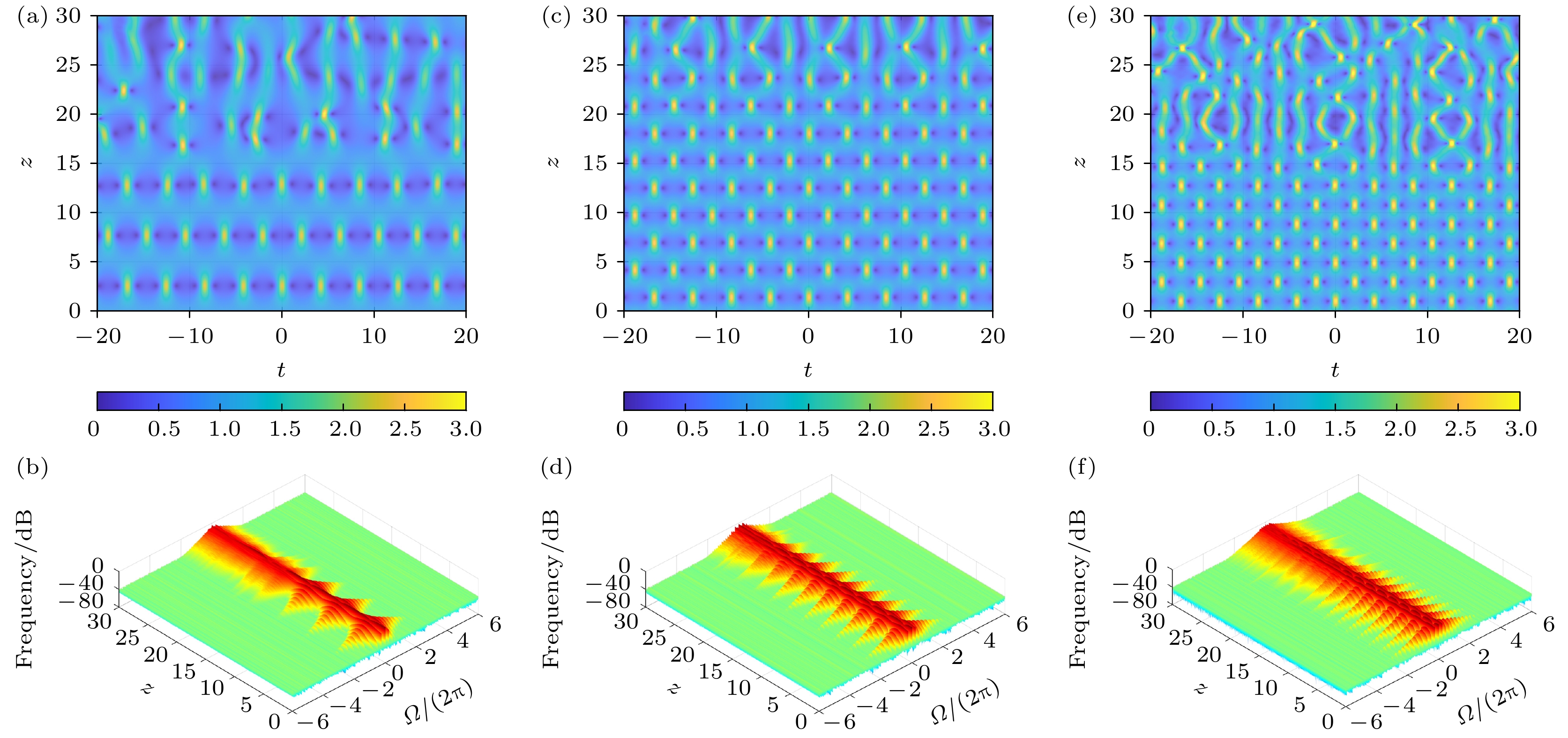
 DownLoad:
DownLoad:
